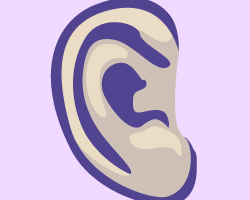
We may not like to think about it too much, but we all need a little earwax.
Earwax traps dust and dirt, preventing it from reaching and damaging the eardrum. It also helps keep the skin of the ear canal healthy.
Usually wax clears out of the ear by moving slowly toward the outside of the ear. When it reaches the ear opening it dries, flakes and falls out.
When your ear needs a hand
However, the ear's wax removal system doesn't always work the way it's supposed to. Earwax can build up; clog the ear canal; and cause pain, hearing problems or ringing in the ear.
Wax blockage often happens because of improper ear cleaning. Cotton swabs, bobby pins and twisted napkin corners can all push wax deeper into the ear.
Most wax buildup can be treated at home, according to the American Academy of Otolaryngology–Head and Neck Surgery (AAO-HNS).
Home treatment
Earwax can be loosened with a few drops of baby or mineral oil. Then, squirt warm water into the canal with a rubber bulb syringe to flush out the loosened wax.
However, don't use any type of irrigation device designed for use in the mouth.
The AAO-HNS warns that ear candles are not an effective or safe wax removal method and using them may result in serious injury.
Professional help
The AAO-HNS recommends seeing a doctor if:
- You can't flush out the wax at home.
- You think your eardrum may have a tear or hole. According to AARP, this may be caused by an infection, quick changes in air pressure, a hard blow to the ear, or an object such as a cotton swab or a hairpin. Symptoms may include temporary hearing loss and pain. If you think your eardrum may be damaged, don't flush your ear at home. Putting fluid in your ear could cause an infection.
Reviewed 11/22/2023